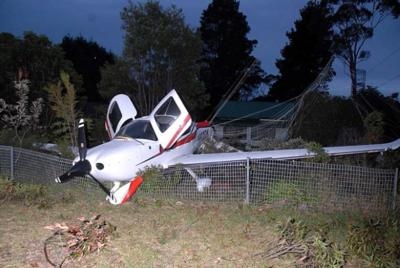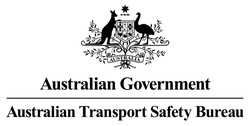SR22 Pilot Deployed Airframe Parachute When Unable To Recover From The Maneuver
The Australian Transport Safety Bureau has released a report from an accident in May involving a Cirrus SR22 aircraft being demonstrated to a potential buyer.

According to the report, the flight originated from Bankstown Airport, New South Wales. The person acting as Pilot in Command is a certified Cirrus sales representative who operated the airplane from the right seat. He is also a certified flight instructor. The prospective buyer was in the left seat. He had been in an SR22 once before, and had expressed some concerns about the stall-spin characteristics of the airplane. A third person was in one of the rear seats of the airplane.
The demo flight included a series of maneuvers to demonstrate the electronic stability of the aircraft. The passenger in the front seat conducted a 30° angle of bank turn. The instructor then described that when 45° angle of bank was exceeded, the electronic stability system increased the pressure against the control stick to return the aircraft to 30° of bank; however that could be overridden by the pilot applying greater force. The PIC then suggested the passenger in the front seat perform a 60° turn to the left.
The passenger in the front seat asked the PIC whether he should increase the power setting prior to commencing the steep turn, however was advised that it was not necessary and the power remained at about 24 inches Hg manifold pressure. He reported that significant back pressure on the control stick was required and he was unable to maintain altitude throughout the steep turn with that power setting.
The PIC then stated that they would demonstrate a stall with the wings level. The passenger in the front seat reduced the power to idle, held the nose of the aircraft up to allow the airspeed to reduce, and the stall warning message appeared on the primary flight display. The PIC directed him to hold that attitude until the stall buffet was felt and then the nose of the aircraft dropped and the passenger in the front seat recovered the aircraft from the stall.
The PIC then took control of the aircraft and stated ‘watch this’. He selected 50% flap, rolled the aircraft into a left turn at about 25° angle of bank, reduced the power to idle, and raised the nose of the aircraft. The passenger in the front seat queried the use of flap and the PIC confirmed it was intended. As the aircraft approached the stall, the PIC pointed to the vertical speed indicator. As he did this, the right wing dropped rapidly and the aircraft entered a spin to the right. The PIC reported that at this time he performed his normal recovery procedure from this manoeuvre: maintained a neutral aileron control position, applied forward pressure on the control stick to pitch the aircraft nose down, rudders neutral and applied power. He reported that he moved the throttle lever forwards to increase power however there was a distinct hesitation in the engine response.

The passenger in the front seat reported that on about the third rotation of the spin, the PIC said ‘I’m sorry’, and he realised that the PIC had lost control of the aircraft. The passenger in the front seat reported that he applied full left rudder in an attempt to counter the rotation.
As the rate of rotation to the right slowed, the passenger in the front seat felt the PIC apply right rudder, and the aircraft again accelerated rotating to the right. When about 2,000 ft above ground level, the PIC was unsure whether he then had enough height remaining to recover control of the aircraft, and elected to deploy the parachute. He reported that at this stage, he said ‘I’m sorry’. The rocket fired and a loud bang was heard. The aircraft initially pitched up slightly and then as the parachute deployed, the aircraft pitched down rapidly into a nose-low attitude. The PIC closed the throttle, selected the fuel mixture to idle cut-off and activated the emergency beacon. He reported that he also selected the fuel to ‘OFF’. About 6 seconds after the rocket fired, the right snub line of the parachute released, followed by the left snub line, which then established the aircraft in a wings level attitude.
The aircraft narrowly avoided some powerlines, collided with branches of a tree, and came to rest on a fence in the garden of a residential dwelling. The passenger in the front seat reported that he observed that the ignition and master switches and fuel selector were still ‘ON’ and selected them to ‘OFF’. He reported that he had to shake the PIC as he appeared dazed, and told the PIC and the passenger to hurry up and open the door and exit the aircraft. The PIC reported that after exiting the aircraft he confirmed that no injuries had been sustained and spoke to National Search and Rescue personnel to confirm that the emergency beacon had been activated.
The demo pilot/flight instructor told the ATSB that he was probably overconfident as he had done the demonstration 30-50 times in the previous 6 months, and that there was no specified routine and series of maneuvers for a demonstration flight, unlike the specific syllabus for the accredited Cirrus ‘transition’ training flights. He added that He thought that as the aircraft entered the spin, the passenger in the left seat had made an uncommanded rudder input, and that he had performed the same maneuvre earlier that day, without the subsequent loss of control.
The passenger in the rear seat said that the overall tenor of the flight had been very informal.
The ATSB said in the report that as a result of this occurrence, the pilot in command has advised the ATSB that he is preparing a set of protocols for demonstration flights, including manoeuvres of a significantly lower level of risk than those included in the training scenarios and a more thorough pre-flight briefing. The Bureau added that the incident provides a reminder to pilots to know your own limitations and those of the aircraft. This demonstrates the importance of thorough planning and preparation for every flight and also of re-assessing when forced to deviate from the plan, such as operating over higher terrain.
(Image provide by New South Wales police force)
 ANN's Daily Aero-Term (04.20.24): Light Gun
ANN's Daily Aero-Term (04.20.24): Light Gun Aero-News: Quote of the Day (04.20.24)
Aero-News: Quote of the Day (04.20.24) ANN's Daily Aero-Linx (04.21.24)
ANN's Daily Aero-Linx (04.21.24) Aero-News: Quote of the Day (04.21.24)
Aero-News: Quote of the Day (04.21.24) ANN's Daily Aero-Term (04.21.24): Aircraft Conflict
ANN's Daily Aero-Term (04.21.24): Aircraft Conflict




